Tree is the largest of all plants. The tallest trees grow higher than 30-story buildings. Many trees also live longer than other plants. Some trees live for thousands of years. They rank as the oldest known living things in the world.
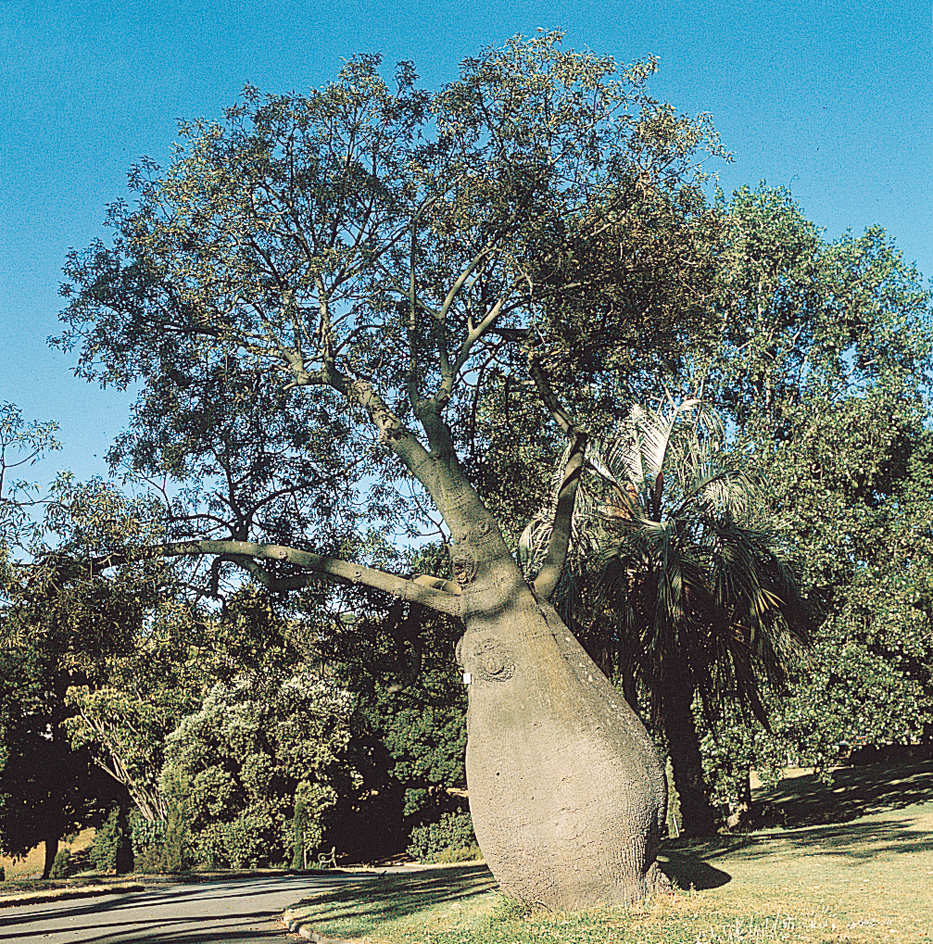
People do not think of trees the way they think of other plants, most of which grow only a short time and then die. People think of trees as permanent parts of the landscape. Year after year, large, old trees shade houses and streets from the sun. Their buds and flowers are a sign of spring each year, and their colorful leaves brighten in autumn in many areas.
Trees continue to grow as long as they live. A tree’s leaves make food that keeps the tree alive and helps it grow. Where winters are cold, many trees lose their leaves in autumn. Other trees keep their leaves during the winter and so stay green all year long. Trees that shed their leaves in autumn rest during the winter. In spring, they grow new leaves and flowers. The flowers grow into fruits, which contain seeds for making new trees. Some tree fruits, such as apples and oranges, taste good. Fruit growers raise large amounts of these fruits for sale. Trees also make new wood each year when the weather turns warmer. Wood ranks as one of the most valuable parts of a tree. Mills and factories use wood to manufacture lumber, paper, and many other products.
A tree differs from other plants in four main ways. (1) Most trees grow at least 15 to 20 feet (4.6 to 6.1 meters) tall. (2) They have one woody stem, which is called a trunk. (3) The stem grows at least 3 to 4 inches (8 to 10 centimeters) thick. (4) A tree’s stem can stand by itself. All other plants differ from trees in at least one of these ways. For example, no plant with a soft, juicy stem is a tree. Most of these plants, called herbs, are much shorter than most trees. Shrubs, like trees, have woody stems. But most shrubs have more than one stem, and none of the stems grows so thick or so tall as a tree trunk. Some jungle vines grow more than 200 feet (61 meters) long and have a woody stem. But the stems of most vines cannot support themselves.
There are thousands of kinds of trees. But most trees belong to one of two main groups—the broadleaf trees and the needleleaf trees. These two types of trees grow in Europe, North America, and many other parts of the world. Most other types of trees, such as palms and tree ferns, grow mainly in warm regions.
The importance of trees
For thousands of years, trees have provided people with foods, fibers, and medicines. Above all, they have provided people with wood. Prehistoric people used wood to make the first spear, the first boat, and the first wheel. Throughout history, people have used wood to make tools, construct buildings, and create works of art. They have also used it for fuel. Living trees are as valuable to humankind as are tree products because they help conserve natural resources.
Wood products.
Each year, loggers cut down millions of trees in the world’s forests. Logs from these trees are shipped to sawmills and pulp mills. Sawmills cut the logs into lumber, which the building industry uses for many types of construction work. Manufacturers use lumber to make everything from furniture to baseball bats. Pulp mills break down the logs into wood pulp, the main raw material for making paper. The chemical industry uses wood pulp to make alcohol, plastics, and other products. See Forest products; Lumber.
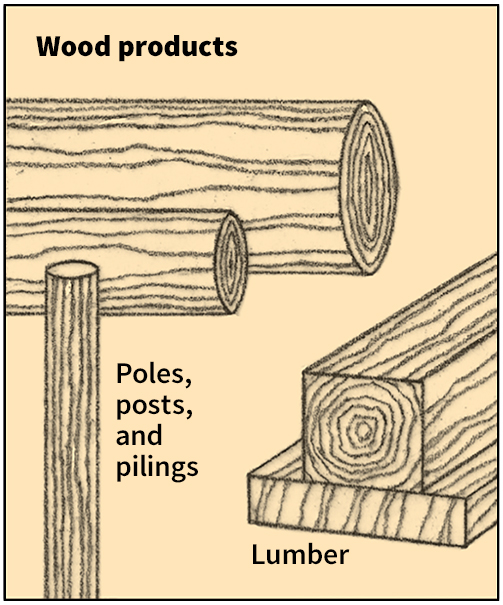
Food products.
People throughout the world eat fruits, nuts, and other tree products. The greatest variety of fruit trees grow in tropical and subtropical regions. These trees produce such fruits as avocados, grapefruits, mangoes, and oranges. A number of these fruits serve as basic foods in some tropical lands. Cooler, temperate regions—such as most of the United States and Europe—have fewer kinds of fruit trees. But several kinds are widely grown. For example, orchards in the United States produce vast amounts of apples, cherries, and peaches. The most important nut tree of warm regions is the coconut palm, which produces coconuts. Nut trees of temperate regions include almonds, pecans, and walnuts. Trees also supply chocolate, coffee, maple syrup, olives, and such spices as cinnamon and cloves. See Fruit; Nut.
Other tree products
are used by people in a variety of ways. The rubber tree produces latex, a milky fluid used to make natural rubber. Pine trees produce a sticky resin, used in making turpentine. The bark of oak and some other trees contains a compound called tannic acid. The tanning industry uses this compound to change animal hides into leather. The spongy bark of a type of oak that grows in Mediterranean countries provides cork. Some trees produce substances used as medicines. For example, the bark of the cinchona tree contains quinine, which doctors use to treat malaria and other diseases. 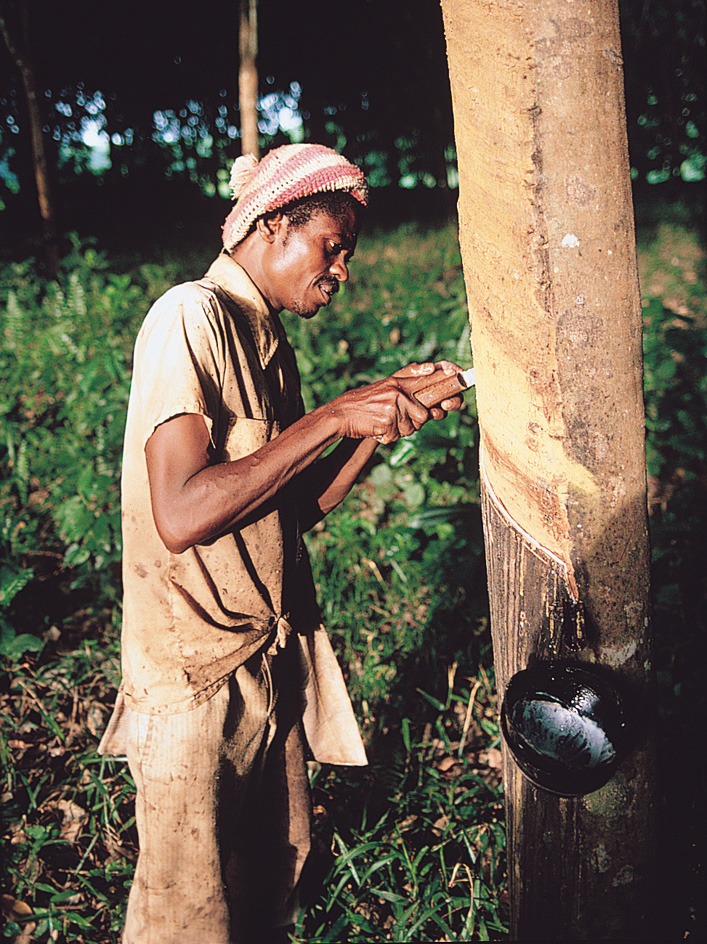
Trees in conservation.
Trees help conserve soil and water. In open country, trees act as windbreaks and keep the wind from blowing away topsoil. Their roots prevent soil from being washed away by heavy rains. Tree roots also help store water in the ground. In mountain regions, forests prevent sliding snow from causing avalanches. Forests also provide shelter for wildlife and recreation areas for vacationers. See Conservation.
Trees help preserve the balance of gases in the atmosphere. A tree’s leaves absorb carbon dioxide from the air. They also produce oxygen and release it into the atmosphere. These two processes are necessary for people to live. People could not survive if the air had too much carbon dioxide or too little oxygen.
Kinds of trees
There are about 20,000 kinds of trees. More than 1,000 kinds grow in the United States. They range from mighty forest trees to fragile ornamentals. The greatest variety of trees grow in wet tropical regions.

Scientists who study plants divide plants with similar characteristics into various groups (see Plant (Kinds of plants). These scientists, called botanists, do not put trees in a separate group of plants. Instead, each kind of tree is grouped with other plants that have certain features in common with it. Therefore, a group of plants may include certain trees, certain shrubs or vines, and certain herbs. For example, locust trees, broom plants, and clover all belong to the same family. These plants are grouped together because they reproduce in the same way and have similar flowers. On the other hand, some trees that look much alike, such as tree ferns and palms, belong to different groups of plants.
Trees also can be divided into six groups according to various features they have in common. These six groups are: (1) broadleaf trees; (2) needleleaf trees; (3) palm, pandanus, and lily trees; (4) cycad trees; (5) tree ferns; and (6) ginkgo trees. 
Broadleaf trees
are the most numerous and varied of the world’s trees. They include ashes, elms, maples, oaks, walnuts, willows, and many other familiar trees of the United States and Canada. They also include most trees of the tropics, such as mahogany trees and mangrove trees.
In addition to their broad, flat leaves, broadleaf trees have other features in common. Almost all broadleaf trees of temperate regions are deciduous—that is, they lose their leaves each autumn. A few kinds of broadleaf trees in temperate regions do not lose their leaves in the fall. These broadleaf evergreens include the holly trees and live oaks of the southeastern United States. Some tropical broadleaf trees are deciduous, but most are evergreen. See Deciduous tree; Evergreen.
Foresters call broadleaf trees hardwoods because many of these trees, such as beeches, maples, and oaks, have tough, hard wood. Such wood makes excellent furniture. Some broadleaf trees, including basswoods and cottonwoods, have soft, lightweight wood.
Broadleaf trees belong to a large group of plants called angiosperms. These plants have flowers which develop into fruits that completely surround the seeds. Fruits are the seed or seeds of a plant together with the parts in which they are enclosed. Botanists divide the angiosperms into several classes. The two main classes are the monocotyledons, or monocots, and the eudicotyledons, or eudicots. Monocotyledons produce seeds that have one leafy structure called a cotyledon. These plants include palm, pandanus, and lily trees. All other angiosperms, including the eudicots, produce seeds that have two cotyledons. These plants include broadleaf trees, as well as a few kinds of trees that do not have broad, flat leaves. For example, the saguaro cactus of the Southwestern United States, which has prickly spines. See Angiosperm; Cotyledon. 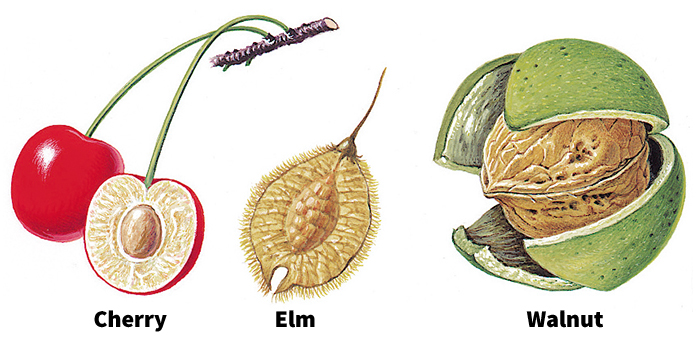
Needleleaf trees
include such familiar trees as firs, hemlocks, pines, redwoods, and spruces. There are about 500 species of needleleaf trees. Most of these trees have narrow, pointed, needlelike leaves. But a few types, such as cedars and junipers, have narrow, scalelike leaves.
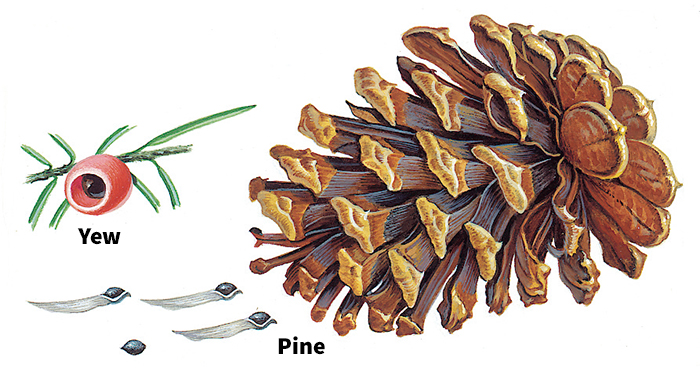
Most needleleaf trees are evergreen, though they produce new needles each year. The oldest needles turn yellow or brown and drop, but the youngest needles remain green and do not fall. A few species of needleleaf trees are deciduous. One kind is the larch, which grows in northern forests throughout the world. Another deciduous needleleaf tree is the baldcypress that grows in swamps of the Southeastern United States.
Foresters call needleleaf trees softwoods because most of them have softer wood than broadleaf trees have. But the wood of Douglas-firs, yews, and some other needleleaf trees is hard.
Needleleaf trees belong to a group of plants called gymnosperms. Gymnosperms do not have flowers and their seeds are not enclosed to form fruits. Most gymnosperm trees bear their seeds in cones composed of hard scales. The seeds lie open on the surface of the scales. Botanists call such trees conifers. See Conifer; Gymnosperm
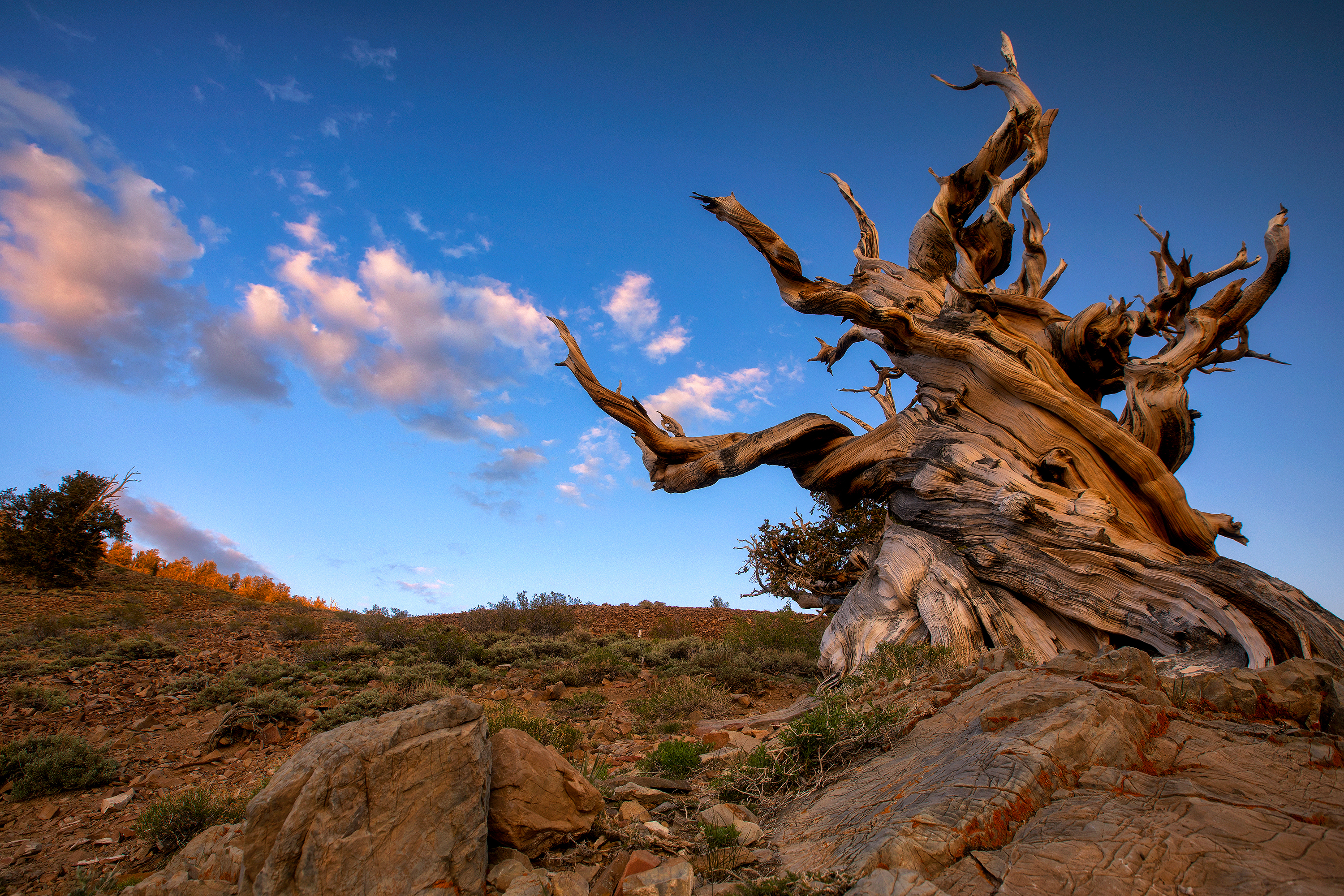
Most conifers grow north of the equator. The conifers belong to four families—the pine, yew, cypress, and taxodium families. The pine family is by far the largest. It includes not only pines, but also such trees as firs, hemlocks, larches, and spruces. Pine trees make up a large genus (group of species) within the pine family. Loblolly pines, ponderosa pines, and white pines are a few North American members of this genus. The yew family includes such well-known ornamental trees as English yews and Japanese yews. Although yews are classified as conifers, they do not produce cones but cup-shaped “berries.” Many members of the cypress family, such as arborvitae and junipers, have scalelike leaves and give off a spicy fragrance. The taxodium family includes baldcypresses and the largest of all living trees—the redwoods and giant sequoias. 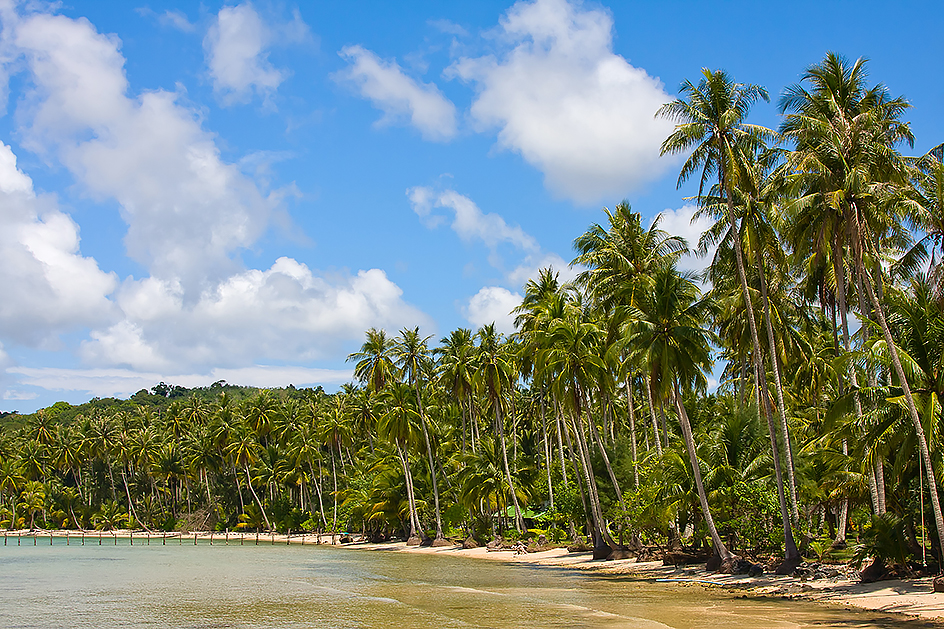

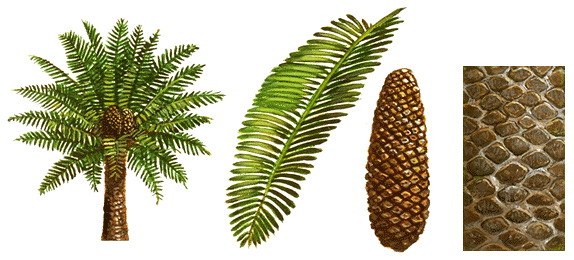
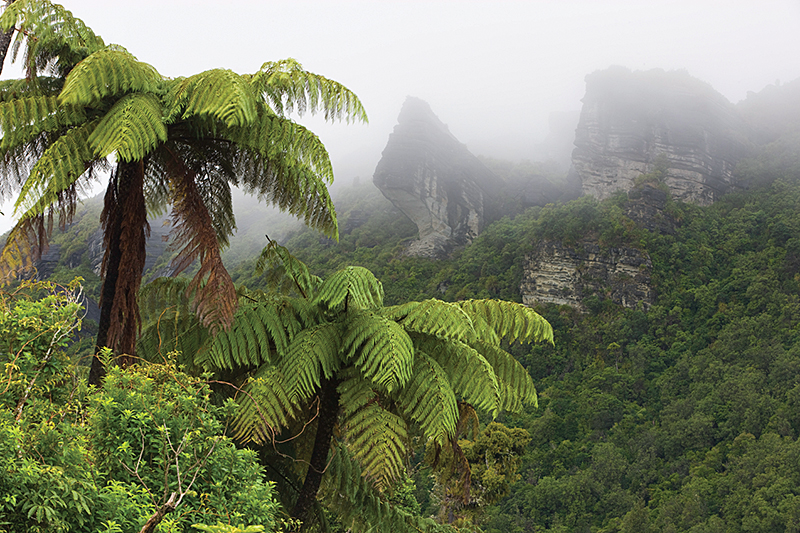
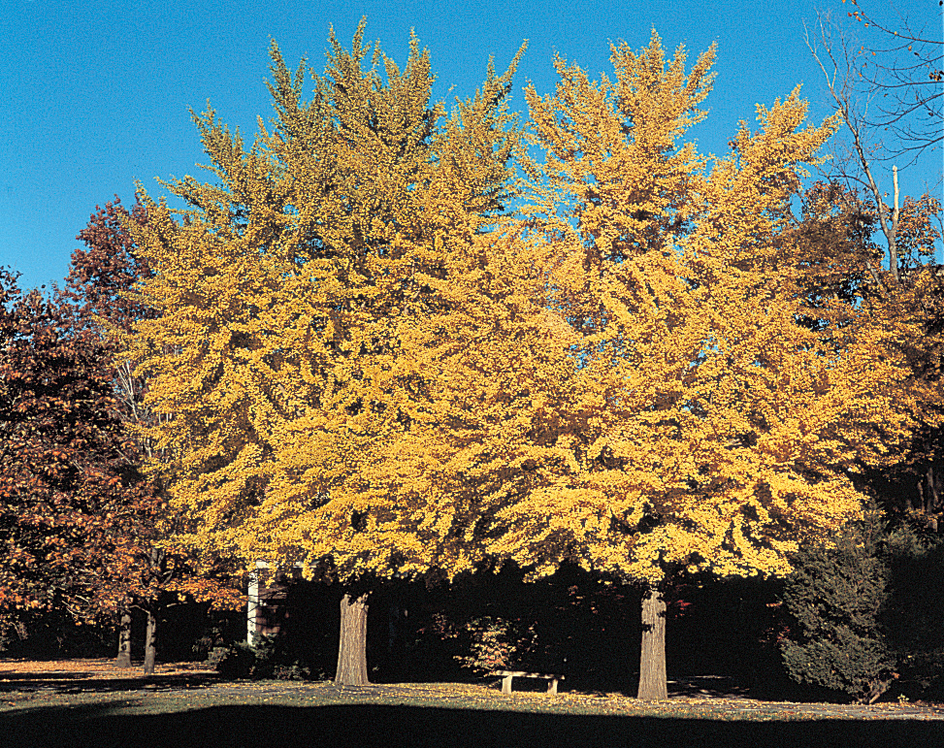
Two conifer families—the podocarpus family and the araucaria family-—grow mainly south of the equator. Podocarpus trees are tall evergreens with broader leaves than those of most needleleaf trees. The araucaria family includes the Chile pine. This strange-looking tree has snakelike branches covered with sharp, scaly leaves. It is sometimes called the monkey puzzle tree because its sharp leaves make it difficult to climb.
Palm, pandanus, and lily trees
belong to the large group of flowering plants called monocotyledons. These trees grow mainly in warm climates. Of the three types of trees in this group, palms are the most important.
There are about 2,500 kinds of palm trees. They range from the coconut palms of tropical islands to the date palms of desert oases. Most palm trees have no branches. The trunk has a crown of enormous leaves. The leaves are either feather-shaped or fan-shaped. See Palm.
Unlike most palms, pandanus and lily trees have branches. Each branch has a crown of sword-shaped leaves. Most pandanus trees have tall stilt roots that extend into the ground from high on the trunk or branches. Lily trees are closely related to the garden flowers called lilies, and many of the trees have attractive, fragrant flowers. The yucca trees of Mexico and the far Southern United States are lily trees. The best-known yucca is the colorful Joshua tree found in the deserts of the Southwestern United States.
Cycad trees
look much like palm trees. They have a trunk without branches and a crown of long, feathery leaves. But cycads are more closely related to pine trees than to palms. They produce seeds in cones that look like large pine cones. Millions of years ago, cycads grew in nearly every part of the world. Today, they grow mainly in a few warm, moist sections of Africa, Asia, and Central America. See Cycad.
Tree ferns.
Ferns are best known as rather short plants with feathery, green fronds (leaves). But in the tropics and some areas with mild climates, many relatives of these plants are trees. Tree ferns look much like palm trees, but they belong to a different group of plants. Tree ferns do not have flowers or cones and so do not reproduce by seeds. They reproduce by means of tiny bodies called spores, which develop on the undersides of their fronds. See Fern.
Ginkgo trees
are an extremely old species of tree. Millions of years ago, various kinds of ginkgoes existed. Only one species survives today. The ginkgo, like needleleaf trees, is a gymnosperm. But unlike other gymnosperm trees, the ginkgo has fan-shaped leaves. These leaves look like the fronds of a fern called the maidenhair. Ginkgoes are sometimes called maidenhair trees. They are natives of Asia, but many are grown in the United States and Europe.
Fossil trees.
About 300 million years ago, there were whole forests of trees unlike most of the trees that grow today. Huge club-moss trees and horsetail trees grew along with tree ferns in steaming hot swamps. Over millions of years, the trees and other plant life in the swamps died, became buried, and turned into coal. In other places, buried forests became petrified (turned into stone). Coal deposits and petrified forests contain fossils of many trees that died out more than 100 million years ago (see Fossil). Two of these extinct trees are the club moss tree and horsetail tree of the coal-forming swamps. The club mosses and horsetails living today are herbs.
The parts of a tree
A tree has three main parts: (1) the trunk and branches; (2) the leaves; and (3) the roots. The branches and leaves together are called the crown. The trunk supports the crown and holds it up to the sunlight. Tree ferns, cycads, and most palms have no branches. Their crowns consist only of leaves. The roots of most trees are hidden in the ground, but they may take up as much space as the trunk and crown do above the ground. Other important parts of a tree include the seeds and the seed-forming structures.
Trunk and branches
give a tree its shape. The trunks of most needleleaf trees grow straight up to the top of the tree. The branches grow out from the trunk. On most needleleaf trees, the branches near the top are shorter than those farther down, which gives the crown a spirelike shape. The trunks of most broadleaf trees do not reach to the top of the tree. Instead, the trunk divides into spreading branches near the base of the crown, giving the crown a rounded shape. The trunks of a few broadleaf trees, such as black willows and white poplars, sometimes divide so close to the ground that the trees seem to have more than one trunk.
The trunks, branches, and roots of broadleaf and needleleaf trees consist of four layers of plant tissue wrapped around one another. These layers, from innermost to outermost, are: (1) the xylem, (2) the cambium, (3) the phloem, and (4) the cork.
The xylem is the woody, central part of the trunk. It has tiny pipelines that carry water with a small amount of dissolved minerals from the roots to the leaves. This water is called sap. The cambium, which surrounds the xylem, is a thin layer of growing tissue. Its job is to make the trunk, branches, and roots grow thicker. The phloem, also called the inner bark, is a layer of soft tissue surrounding the cambium. Like the xylem, the phloem has tiny pipelines. The food made by the leaves moves through the phloem to the other parts of a tree. In palms and tree ferns, the xylem and phloem are not separate layers. Instead, bits of xylem and phloem are connected and form small double pipelines scattered throughout the trunk.
The cork layer is the outer bark of a tree. It forms a “skin” of hard, dead tissue that protects the living inner parts from injury. The bark stretches to let the trunk and branches grow thicker. The bark of some trees, such as beeches and birches, is smooth because it stretches easily. But the bark of most other trees does not stretch so well. As the trunk and branches grow thicker, they push against the bark. It finally cracks and dries and so becomes grooved and rough. Most trees replace old bark from time to time with a new layer.
Leaves
of various species of trees differ greatly in size and shape. Palms have leaves over 20 feet (6 meters) long. The leaves of some needleleaf trees are less than 1/2 inch (13 millimeters) long. Some broadleaf trees have compound leaves made up of small leaflets.
The main job of the leaves is to make food for the tree. Every leaf has one or more veins, which consist of xylem and phloem tissue. The tissue that surrounds the veins contains tiny green bodies called chloroplasts. Water from the roots passes through the xylem of the trunk, branches, and leaves to the chloroplasts, which use the water to make food sugar. Only a small amount of the water carried to the leaves is used to make sugar. The leaves lose most of the water to the atmosphere through transpiration (evaporation). Like the water and dissolved minerals carried from the roots, the food made by the leaves is also called sap. It travels through the phloem of the leaves, branches, and trunk to parts of the tree where it is needed. See Sap.
Almost all leaves are green in the spring and summer. Their color comes from chlorophyll, a green substance in the chloroplasts. Most trees also have reds and yellows in their leaves. But the green conceals these colors. In late summer and early autumn, the chlorophyll in the leaves of many broadleaf trees breaks down. The leaves then die. But before the leaves fall, they reveal their hidden reds and yellows. After the chlorophyll breaks down, the leaves of many trees also develop scarlets and purples. See Leaf (The leaf changes color)
Roots
are long, underground branches of the trunk. They have the same layers of tissue as the trunk. The roots anchor a tree in the ground and absorb water with dissolved minerals from the soil. The main roots branch out into small roots, which, in turn, branch out into still smaller roots. The main roots of most trees begin to branch out 1 or 2 feet (30 or 61 centimeters) under the ground. Some trees have one main root larger than the others. This root, called a taproot, extends straight down 15 feet (5 meters) or more.
A tree develops millions of small roots. Each root grows longer at its tip, which is as small as a thread. As a root tip grows, it pushes through particles of soil. Thousands of fine, white root hairs grow just back of the root tip. When the tip comes in contact with drops of water in the soil, the hairs soak up the water and dissolved minerals. The xylem layer of the roots, trunk, and branches carries this sap to the leaves.
Fungi grow on the roots of most trees in a helpful relationship called mycorrhiza. The fungi aid the roots in absorbing water and mineral nutrients. They also protect the roots from some diseases.
Seeds
are the means by which all trees except tree ferns reproduce. Tree ferns reproduce by spores.
Angiosperms—broadleaf trees and palm, pandanus, and lily trees—produce seeds by means of flowers. Some broadleaf trees, such as horsechestnuts and magnolias, produce large, showy flowers. Many others have small, plain-looking flowers. Most palm, pandanus, and lily trees have small flowers that grow in bunches. Sometimes these are brightly colored and fragrant.
The seeds of angiosperms are enclosed to form a fruit. The fruits of some broadleaf trees, such as apples and cherries, have a fleshy outer covering. The fruits of other broadleaf trees, including acorns and beechnuts, are hard nuts. Ashes, elms, and maples have thin, winged fruits. Palm, pandanus, and lily trees have a variety of fruits, ranging from nuts to berries.
Gymnosperms—needleleaf trees, cycads, and ginkgoes—do not have flowers or fruits. Their seeds are produced in cones or similar structures. The seeds of needleleaf trees and cycads have no protective coverings. Ginkgo seeds have a fleshy outer covering, but the covering is not a true fruit.
How a tree grows
Most trees begin life as a seed. The young tree that develops from this seed is called a seedling. After a tree reaches a height of 6 feet (1.8 meters) or more and its trunk becomes 1 to 2 inches (2.5 to 5 centimeters) thick, it is called a sapling. Many trees reach a height of more than 100 feet (30 meters). Some old trees have trunks more than 10 feet (3 meters) in diameter.
Trees need great amounts of water. A large apple tree in full leaf may absorb 95 gallons (360 liters) from the soil daily. Most of the water goes to the leaves. On a sunny summer day, some trees move water up through their trunks at the rate of 3 feet (91 centimeters) per minute. A tree’s wood is about half water.
How seeds sprout into trees.
A seed contains parts that develop into the trunk and roots of a tree. It also has one or more cotyledons and a supply of plant food. After a seed has left the parent tree, it rests for a while on the ground. Water, air, and sunshine help the seed germinate (begin to grow). The part of the seed that develops into the trunk points upward toward the sunlight. As the seed absorbs water, the root part swells and bursts through the seed’s shell. As the root grows, it pushes down into the soil. The food stored in the seed nourishes the tree. As the root begins to soak up water from the soil, the trunk begins to develop leaves.
How leaves make plant food.
As a leaf develops, it gets sap from the roots. It also absorbs carbon dioxide from the air. The leaf uses the energy of sunlight to change the sap and carbon dioxide into sugar, a process called photosynthesis. The sugar provides food for the trunk, branches, and roots. During photosynthesis, the leaves also produce oxygen and release it into the atmosphere. See Leaf (How a leaf makes food).
How trees grow taller.
Trees grow taller only at the tips of their trunk and branches. Each year, the tips of the trunk and of each branch develop a bud. The bud contains a tiny leafy green stem called a shoot. The bud is wrapped in a protective covering of bud scales. After a period of rest, the buds swell and open. The shoots that were inside the buds begin to grow and so make the trunk and branches taller. Another type of bud grows on the sides of the trunk and branches. These buds contain a shoot that develops into a leaf-bearing twig after the bud opens. As a twig grows larger, it becomes another branch of the tree. Some tree buds develop into flowers. Still others develop into twigs that bear both leaves and flowers. In warm climates, trees produce buds frequently during the year or continue to grow without forming buds. In colder climates, trees produce buds only in the summer. These buds rest in winter and open after warm weather arrives in spring.
Trees without branches—cycads, most palms, and tree ferns—grow somewhat differently. For example, a young palm tree does not grow taller for a number of years. Its short trunk thickens and produces more and larger leaves each year. After the trunk and crown reach adult size, the tree begins to grow taller. The trunk stays about the same thickness for the rest of the tree’s life.
How trunks and branches grow thicker.
The trunk and branches of a broadleaf or needleleaf tree grow thicker as long as the tree lives. The cambium tissue just underneath the inner bark causes this thickening. It uses the sugar produced by the leaves to make new plant tissue. On its outside, the cambium makes new phloem, or inner bark, and on its inside, new xylem, or wood.
Wood consists largely of cellulose, a tough substance made from sugar. The xylem has two kinds of wood—sapwood and heartwood. The wood nearest the cambium is the sapwood. It is living wood and contains the tiny pipelines that carry sap. In tropical climates, the sapwood thickens all year. In cooler climates, a new layer of sapwood usually forms only in early summer. As a tree ages, the wood nearest the center dies. This dead wood is the heartwood. It helps support the tree.
In regions where trees make a new layer of wood once a year, the layers form a series of annual rings. Each ring represents one year’s growth. After such a tree has been cut down, a person can count the rings to determine the tree’s age. Scientists have also found that slight changes in the thickness of these rings reveal the kind of weather that a tree experienced during each year.
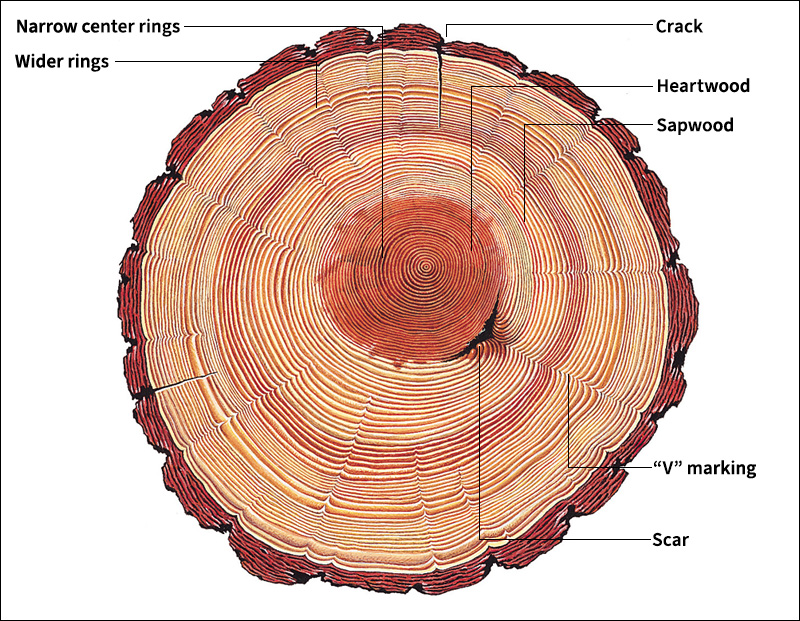
How trees reproduce.
Most trees reproduce sexually. That is, seeds are produced only after sperm unite with eggs. Sperm are produced by pollen, which forms in the tree’s male reproductive parts—either the male part of the flower or the male cone. Eggs form in the female part of the flower or in the female cone. Among many angiosperm species, the flowers have both male and female parts. The pollen from the male part can simply drop onto the female part. Other angiosperms and all gymnosperms have separate male and female flowers or cones, which may grow on the same tree or on separate trees. The pollen of these species is carried to the female flower or cone by insects, the wind, or other means. After contacting the female flower or cone, pollen produces sperm. The sperm then unite with eggs, and one or more seeds develop within a fruit or cone.
When the fruit or cone has ripened, the seeds are ready to leave the tree. The wind scatters the seeds of needleleaf trees and the winglike seeds or fruits of such broadleaf trees as ashes, maples, poplars, and willows. Birds, squirrels, and other animals scatter seeds contained in nuts or fleshy fruits. Ocean currents sometimes carry the seeds of coconut palms and mangroves.
Trees can also reproduce by a process called vegetative reproduction. After a tree has been cut or blown down, the stump may develop green sprouts. In time, one or several of these sprouts can grow into trees. A clump of birches or yellow-poplars may be produced in this way. The roots of apple trees, aspens, and some other trees sometimes develop shoots called suckers that may also grow into trees. Some spruces found in bogs grow roots from their branches. This method of reproduction is called layering. In addition, nursery workers often grow trees from cuttings—that is, twigs cut from older trees. The twigs are planted and develop roots.
Broadleaf and needleleaf trees
This section illustrates some of the chief characteristics of various broadleaf and needleleaf trees around the world. The drawings show the summer and winter appearance of each species. They also illustrate the leaf; the fruit or other seed-bearing structure; and, in most cases, the bark. For some species, the flower is shown. Each set of illustrations includes information about the tree’s native geographic range—that is, the part of the world where the tree is most likely to be found. But a number of the species shown have spread or have been planted outside their native range. The average height of adult trees of each species is given in feet and in meters alongside the illustration of the tree’s shape.

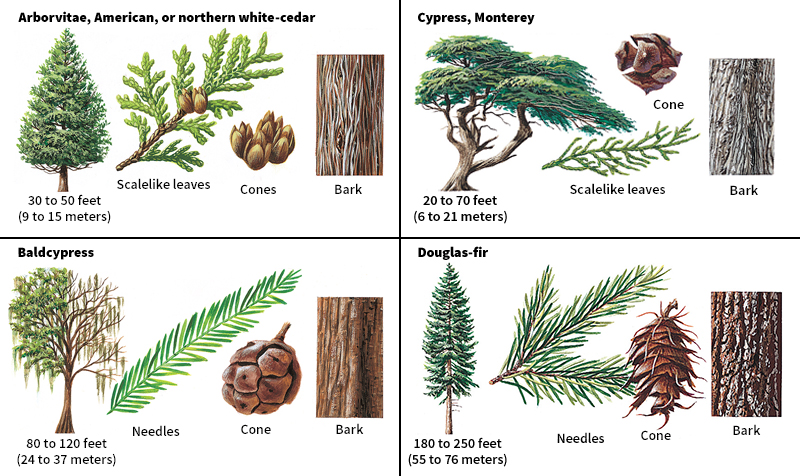
The drawings and other information in this section can help in identifying trees. For example, if the leaf and bark of a tree match the leaf and bark of one of the trees shown here, the tree should be fairly easy to identify. Tree guidebooks can provide additional help in identifying trees. Several guidebooks are listed in the Study aids at the end of this article.
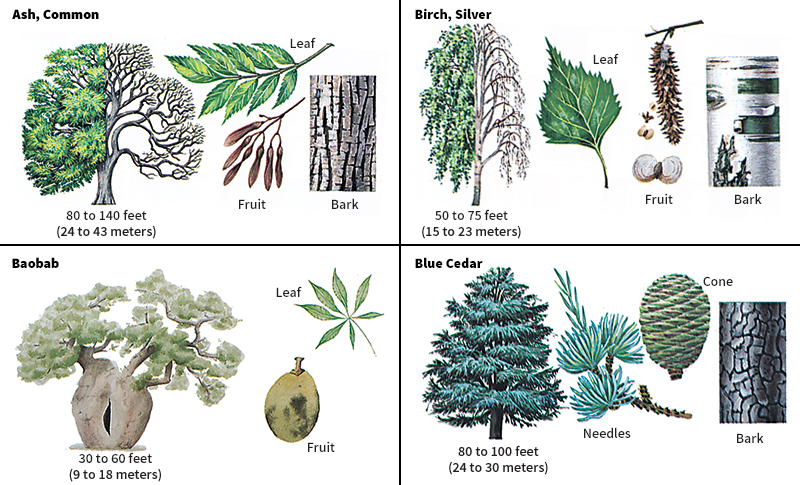
Trees around the world
In some parts of the world, trees grow in thick forests. In other regions, they do not grow at all. To grow, trees need a period of more than two months without frost each year. The few trees that grow in the Arctic never reach full tree size. No trees can grow in the ice and bitter cold of Antarctica. Most trees also need at least 15 to 20 inches (38 to 51 centimeters) of rainfall a year. Only a few trees, such as the Joshua tree and some types of palms, can survive in deserts.
Most broadleaf trees grow best in regions that are warm and moist at least three or four months of the year. Colder, dryer climates are better suited to most needleleaf trees. But some broadleaf trees, such as birches and willows, grow well in cool climates. Some needleleaf trees, including baldcypresses and various types of pines, need fairly warm climates. Palm trees grow in warm areas throughout the world, especially the wet and the dry tropics. Pandanus trees, cycads, and tree ferns grow mainly in the wet tropics and other warm, moist regions. Lily trees also thrive in warm areas, but they do not need so much moisture as do pandanus trees, cycads, and tree ferns.
Different kinds of trees also require different soils. Many needleleaf trees grow well in poor, sandy soil. But most broadleaf trees need more fertile soil.
Some trees grow alone or in small groups. Where moisture is scarce, trees may grow only along riverbanks. Tree seeds carried by ocean currents may take root along shorelines. People plant individual trees in such places as parks and gardens. But most trees by far grow in forests. The world’s forest regions consist chiefly of broadleaf and needleleaf trees.
Broadleaf forests
grow in regions that have a fairly long growing season and plentiful rainfall. Every continent except Antarctica has broadleaf forests, which are also called hardwood forests. In areas with cold, snowy winters, almost all the trees in broadleaf forests lose their leaves each autumn. In tropical areas, most broadleaf trees are evergreen.
Before the 1800’s, broadleaf forests covered much of the Eastern United States. They included such trees as ashes, birches, maples, and oaks. During the 1800’s, most of the trees in these forests were cut down to provide lumber and fuel and to make room for farms and cities. Today, only a few parts of the Eastern United States have large broadleaf forests. Western Europe also had great forests of broadleaf trees, including ashes, beeches, and oaks. But most of these forests have been cut down.
Broadleaf forests that consist largely of quaking aspens and balsam poplars cover parts of southern Canada and large areas of southern Siberia. Forests of birches and oaks grow in eastern Europe and along the Yellow Sea coast of China and Korea. Southeastern Australia has valuable forests of eucalyptus trees. These broadleaf trees grow nearly as tall as California’s needleleaf giants, the redwoods. Some eucalyptus trees stand more than 300 feet (91 meters) tall. About 600 kinds of eucalyptus trees grow in Australia. Almost all of these trees are evergreen. 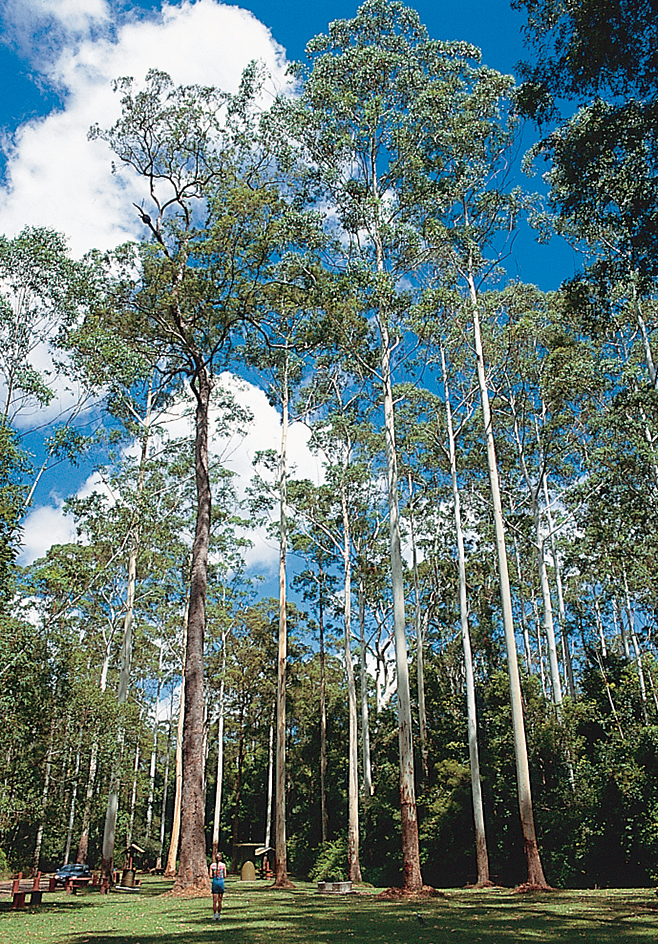
In many areas, mixed forests of broadleaf and needleleaf trees grow alongside broadleaf or needleleaf forests. Central Canada, the Eastern United States, central and southern Europe, and eastern Asia all have large mixed forests.
Remarkable broadleaf forests grow in tropical regions where the weather is always hot and rain falls regularly every month of the year. In these tropical rain forests, many of the trees look alike. They are tall, and many tower more than 150 feet (46 meters) high. The trees have leathery, dark-green leaves. Because the trees receive plenty of moisture throughout the year, most of them are evergreen. The trees may thus look alike, but they belong to many species. Many palms grow among the broadleaf trees in the tropical rain forests. The largest rain forests are in South and Central America, central Africa, and Southeast Asia.
Needleleaf forests
grow mainly in regions that have long, cold winters. These forests, which are also called softwood forests, stretch across Canada, northern Europe, and Siberia. Many firs, larches, and spruces grow in these northern forests, along with a few broadleaf trees, such as birches and willows. Some willows grow even farther north than needleleaf trees do. But they seldom reach more than shrub size. Needleleaf forests also blanket slopes in such mountain ranges as the Alps and the Rocky Mountains.
The Canadian needleleaf forests extend southward into the Western United States, where they include many of the world’s largest trees. Many California redwoods tower over 300 feet (91 meters) tall. Tall Douglas-firs also grow in the Western United States.
A few needleleaf forests grow in warmer regions. For example, the southeast United States has large forests of pines, such as loblolly pines and longleaf pines. These forests provide great quantities of wood for lumber and wood pulp.
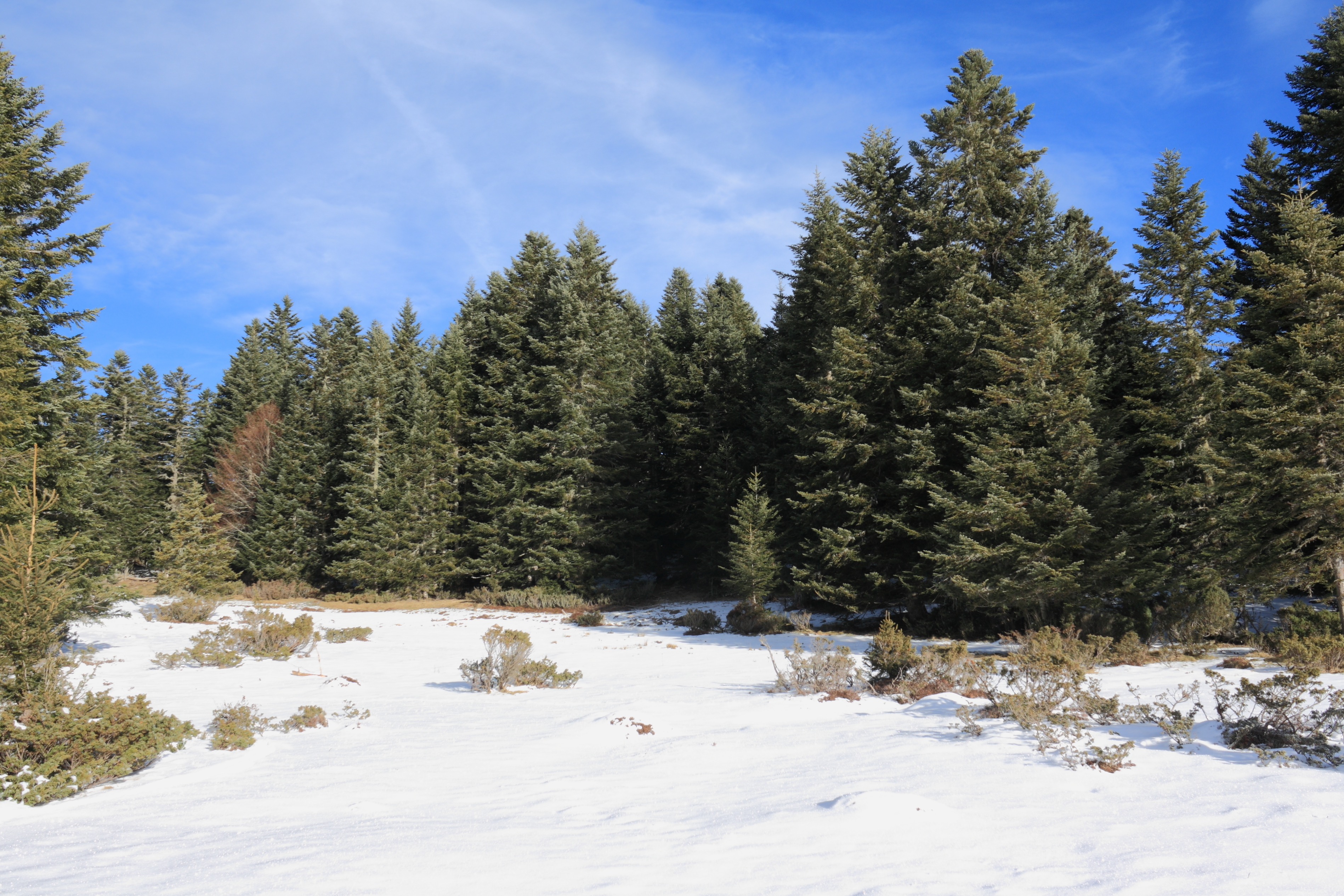
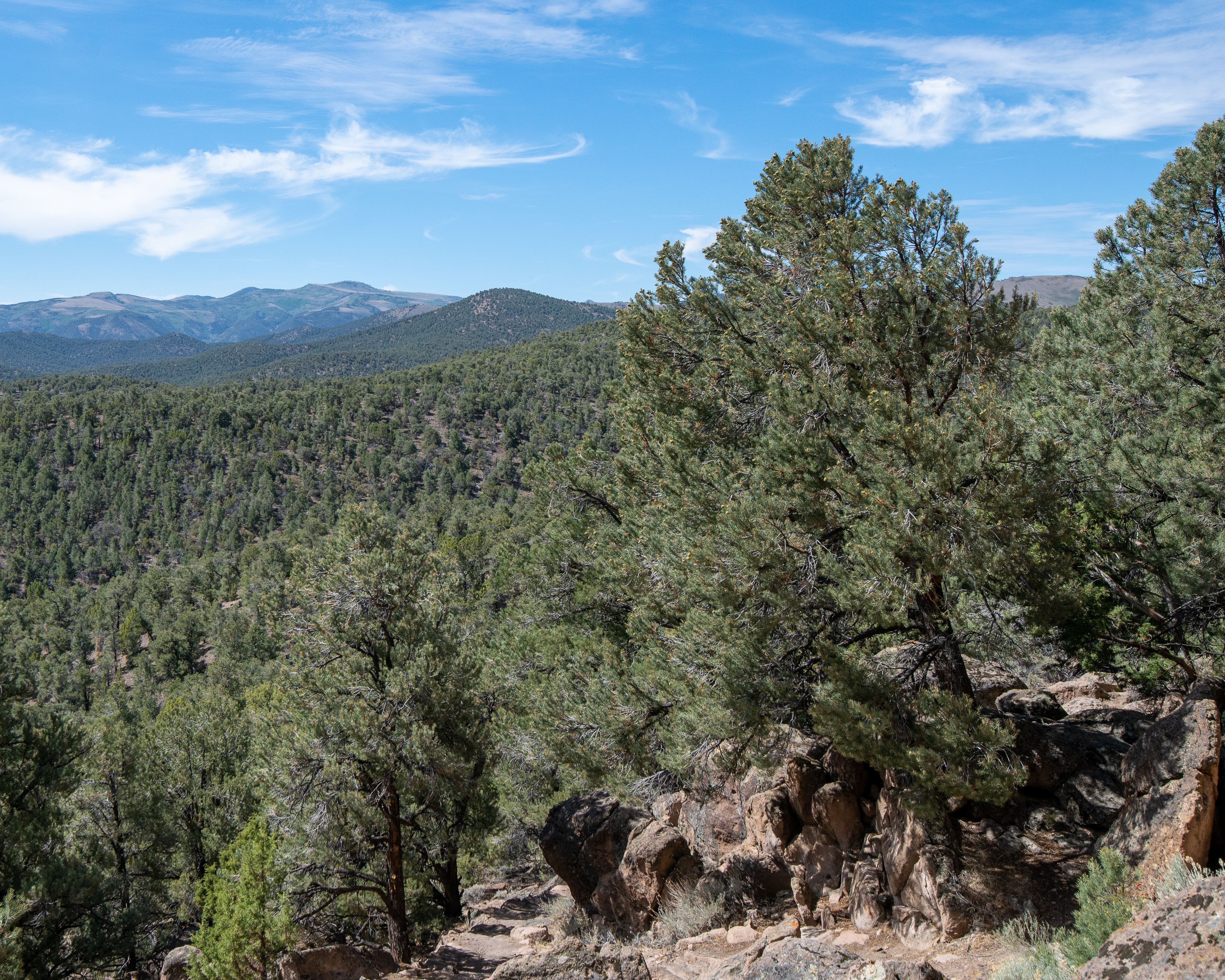
How forests spread.
Many forests did not always grow where they are growing now. These forests have spread from other areas. For example, broadleaf forests grow today in parts of the northeast United States where only needleleaf forests grew several thousand years ago. The spread of forests from one area to another is called migration. The wind helps trees migrate by carrying their seeds beyond the forests. Animals also help spread the seeds. Trees that grow from these seeds produce their own seeds, which may be spread in the same ways. Over hundreds or thousands of years, a particular kind of tree may thus spread to surrounding areas if the climate and soil are suitable.
From about 2.6 million to 11,500 years ago, glaciers advanced and retreated several times across much of North America and Europe. When advancing, these glaciers caused forests of needleleaf and broadleaf trees to migrate south. When the glaciers began melting and retreating, forests of needleleaf trees grew up again on the land the glaciers had covered. As the glacial retreating continued, the climate became warm enough for broadleaf trees. Broadleaf trees usually crowd out needleleaf trees in areas where both are able to grow. As a result, broadleaf forests would often replace needleleaf forests. See Ice age.
Forests can migrate over fairly level land but not across oceans or mountain ranges. Yet similar types of forest trees grow in areas separated by oceans or mountains. For example, the United States has oak trees much like those that grow in Europe. Most scientists believe that many millions of years ago, all the continents were connected. Needleleaf trees developed and spread across much of Earth. Broadleaf trees developed next and also spread. Over millions of years, the continents became separated—along with their trees and other forms of life-—by the oceans. Mountain ranges rose up on the continents and separated the trees on each side of the mountains. In time, many of the trees on each continent and on each side of the mountain ranges developed into different species.
How people help trees spread.
People have transplanted many species of trees across oceans and mountain ranges. Transplanted trees may grow well in a new region with a climate like that of their native lands. In time, these introduced species may spread and become native trees in their new surroundings. A kind of rubber tree that once grew only in Brazil was introduced into the Far East during the late 1800’s. Today, whole forests of these trees grow in the Far East. About 100 years ago, Australian eucalyptus trees were planted in California. Today, many thousands of eucalyptuses shade streets and parks in several Western states. Monterey pines originally grew only in a small area of California. They now cover large areas in Australia and other countries south of the equator.
Planting and caring for trees
Homeowners plant various kinds of trees on their property. They plant shade trees for protection from the sun and ornamental trees for beauty. They may also plant trees as windbreaks. Many people enjoy having fruit trees in their yard or garden to provide shade and beauty as well as fruit.
Selecting the right tree.
To grow well, a tree must be suited to the region where it is planted. Trees from faraway places should be planted only in regions with similar climates. A tree’s special characteristics must also be considered. For example, trees with wide-reaching roots should not be planted near houses because the roots may damage drains and foundations, or plug sewage pipes.
Trees with full, leafy crowns make the best shade trees. The most popular of these trees include ashes, basswoods, maples, and oaks. Trees with showy flowers, such as the catalpa and the crab apple, rank among the most commonly planted ornamental trees. In fairly warm areas around the world, such trees as acacias and pepper trees are planted as both shade and ornamental trees. Needleleaf trees are grown as ornamentals in many regions. They also make good windbreaks. Various broadleaf trees, including cottonwoods and Lombardy poplars, are also planted as windbreaks. Apple and cherry trees are popular fruit trees in temperate climates. In warm climates, many people prefer to grow citrus trees.
Planting the tree.
A tree should be planted where it will have enough room when fully grown. The soil should be fertile and should drain well so that water does not collect and drown the roots. 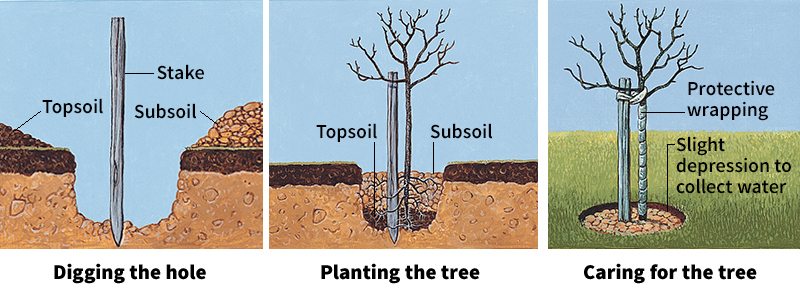
The effort to grow a tree from seed takes much time. Most people prefer to buy their trees from a nursery. If a nursery tree measures more than 15 feet (4.6 meters) tall or if its trunk measures more than 3 inches (8 centimeters) thick, the grower may need special transplanting equipment.
The best time to transplant a tree is when it is resting—that is, in the fall, winter, or early spring. The roots of a deciduous tree can be dug up without a covering of soil. But a grower must keep the roots moist while they remain out of the ground. The roots of an evergreen should be dug up with a ball of soil around them. The hole for any new tree should provide room for all the roots below ground level. A small tree may need to be supported by stakes to keep the wind from blowing it over. 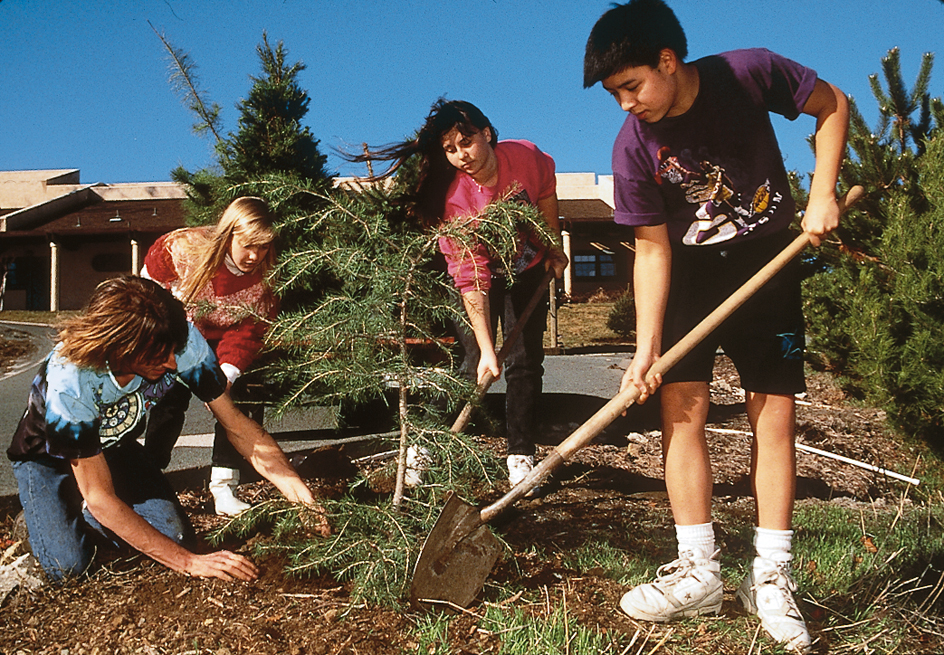
Caring for the tree.
A young tree should be kept moderately watered until it is well rooted in the ground. It usually takes about a year for a tree to become firmly rooted.
Pruning improves the shape of trees. Cutting off some of a young shade tree’s lower buds will keep it from developing many low branches. But enough buds should be left so that the tree has a full, leafy crown. As the tree develops upper branches, more lower branches may be removed. See Pruning.
Insects and diseases may attack a tree. With normal care, it can overcome most minor attacks. But if a tree fails to develop as many leaves as usual or if the leaves look pale, the tree may require the professional care of a tree surgeon. In some areas, air pollution threatens the health of trees.
